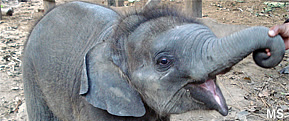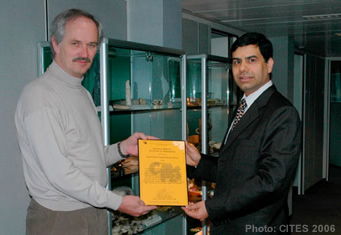 |
Chitwan National Park |
|
 |
|
CITES
awards Certificate of Commendation to Nepal authorities for their combat
against wildlife poachers and traffickers
|
 |
March
2006
The
Secretary-General of the Convention on International Trade in Endangered
Species of Wild Fauna and Flora (CITES) has today awarded a Certificate
of Commendation to the Chitwan National Park Authority and to the
Royal Nepalese Army to recognize their exemplary efforts to combat poaching
and illegal trade in endangered species, in particular the leopard, the
rhinoceros and the tiger.
During
2004 and 2005, officers from both the Authority and the Army arrested over
30 people for wildlife crimes: many of them were subsequently sentenced
to prison. They also seized rhinoceros horns, tiger skins, and tiger and
leopard bones, and confiscated illegal earnings as well as vehicles, weapons
and ammunition.
The
Certificate was presented during a ceremony at the offices of the CITES
Secretariat. It was accepted on behalf of the Authority and the Army by
His Excellency The Ambassador and Permanent Representative of Nepal to the United Nations and other international organisations
at Geneva.
 |
| Accepting the certificate of commendation, Mr Gyan Chandra Acharya,
the Nepalese Ambassador, expressed the sincere gratitude of the
Government of Nepal to the CITES Parties and the Secretariat for the recognition
of the dedicated work of the Chitwan National Park Authority and
the Nepalese Army to combat poaching and illegal trade in endangered
species even in difficult circumstances, as per its commitment to international
conventions. |
|
He
further said that such commendation would encourage the authorities involved
to work with further dedication to the cause of the protection of the endangered
species and preservation of their biodiversity in the days ahead. He also
assured that he would be pleased to forward the commendation to the respective
authorities in Nepal.
Speaking
after the presentation, Secretary-General Willem Wijnstekers said, "The
poaching of animals such as tigers and rhinoceroses has brought some populations
of these species to the brink of extinction. Many criminals involved in
poaching do not hesitate to act violently towards law enforcement personnel,
which makes the dangerous work performed by Park staff and by the Army
in Nepal all the more impressive."
Mr
Wijnstekers also commended the Nepalese authorities for their strong commitment
to protecting their country's biodiversity during a period when law enforcement
agencies face many other demands upon their time and resources.
The
CITES Secretary-General began awarding Certificates of Commendation in
2002 to recognize exemplary enforcement actions by individuals or organisations
that have contributed to the enforcement of the Convention.
|
What
is CITES?
|
 |
CITES
(the Convention on International Trade in Endangered Species of Wild Fauna
and Flora) is an international agreement between Governments. Its aim is
to ensure that international trade in specimens of wild animals and plants
does not threaten their survival.
Widespread
information nowadays about the endangered status of many prominent species,
such as the tiger and elephants, might make the need for such a convention
seem obvious. But at the time when the ideas for CITES were first formed,
in the 1960s, international discussion of the regulation of wildlife trade
for conservation purposes was something relatively new. With hindsight,
the need for CITES is clear. Annually, international wildlife trade is
estimated to be worth billions of dollars and to include hundreds of millions
of plant and animal specimens. The trade is diverse, ranging from live
animals and plants to a vast array of wildlife products derived from them,
including food products, exotic leather goods, wooden musical instruments,
timber, tourist curios and medicines. Levels of exploitation of some animal
and plant species are high and the trade in them, together with other factors,
such as habitat loss, is capable of heavily depleting their populations
and even bringing some species close to extinction. Many wildlife species
in trade are not endangered, but the existence of an agreement to ensure
the sustainability of the trade is important in order to safeguard these
resources for the future.
Because
the trade in wild animals and plants crosses borders between countries,
the effort to regulate it requires international cooperation to safeguard
certain species from over-exploitation. CITES was conceived in the spirit
of such cooperation. Today, it accords varying degrees of protection to
more than 30,000 species of animals and plants, whether they are traded
as live specimens, fur coats or dried herbs.
CITES
was drafted as a result of a resolution adopted in 1963 at a meeting of
members of IUCN (The World Conservation Union). The text of the Convention
was finally agreed at a meeting of representatives of 80 countries in Washington
DC., United States of America, on 3 March 1973, , and on 1 July 1975 CITES
entered in force. The original of the Convention was deposited with the
Depositary Government in the Chinese, English, French, Russian and Spanish
languages, each version being equally authentic.
CITES
is an international agreement to which States (countries) adhere voluntarily.
States that have agreed to be bound by the Convention ('joined' CITES)
are known as Parties. Although CITES is legally binding on the Parties
- in other words they have to implement the Convention - it does not take
the place of national laws. Rather it provides a framework to be respected
by each Party, which has to adopt its own domestic legislation to ensure
that CITES is implemented at the national level.
For
many years CITES has been among the conservation agreements with the largest
membership, with now 169 Parties.
|
Links
|
 |
 |
 |
External
links |

|



